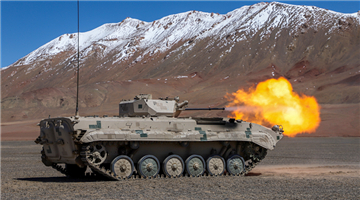By Wu Minwen
The Biden administration recently submitted its first fiscal year defense budget to Congress, totaling $752.9 billion. Its structural adjustment is to reduce overseas intervention and emergency military operations, increase innovative research and development efforts, and promote the transformation of the US military and the improvement of its combat effectiveness. This is not only the continuation of the US military preparations focusing on great-power competition as it withdrew from the Middle East regions such as Iraq, Syria, and Afghanistan in recent years, but also indicates the main direction of future US defense strategy and military expenditure.
Eliminating outdated equipment to optimize the equipment structure, fully developing high-tech and equipment, and optimizing the personnel structure manifest that the US military is taking advantage of the inter-war period to promote the transformation of military construction, upgrade combat effectiveness, strive to expand its advantages and ensure its hegemony.
Large-scale equipment retirement will reduce the size of the surface fleet and the Air Force aircraft of the US. But compared with that of other countries, even the equipment to be phased out by the US military still has great advantages. For example, fifth-generation fighter jets such as F-22 and F-35 replacing the fourth-generation are currently the main fighter jets of the US military. However, the second-generation F-4 Phantom fighter jets are still used by Iran.
Meanwhile, although the total amount of US military weapons purchases and the size of active forces have declined in the new fiscal year, the purchase of precision ammunition increases significantly. While the purchase of conventional ammunition drops sharply from $5 billion in the last fiscal year to $3.9 billion, the purchase of precision ammunition such as air-to-ground precision-guided munition that can strike maneuvering targets increases continuously.
The budget for research, development, testing, and appraisal is as high as $112 billion, an increase of 5.1 percent over the 2021 fiscal year. The budget is mainly invested in microelectronics, hypersonic missiles, artificial intelligence, cyberspace capabilities, and 5G networks. Especially in hypersonic weapons, the budget of $3.8 billion will enable the US Army, Navy, and Air Force with the capability of hypersonic long-range precision strikes. The $27.7 billion in the energy sector will be used for the modernization of nuclear delivery capabilities, mainly including the research and development of strategic bombers, ballistic missile submarines, next-generation air-launched strategic cruise missiles, and land-based intercontinental ballistic missiles.
In terms of personnel composition, the new fiscal year budget requires that the total number of US military active and reserve forces will be reduced from 2,150,375 in fiscal 2021 to 2,145,900, a reduction of 4,475. However, the number of space forces has grown against the trend, expanding from 6,434 in fiscal 2021 to 8,400, an increase of 1,966. This reflects that the US military attaches great importance to the space military, which is also an overall optimization of the US military personnel structure.
The Biden administration continued to increase the military budget on the basis of the high military expenditures of the previous administration, which is not only kidnapped by Trump's policies, but also of the Biden administration’s own accord.
On the one hand, the Indo-Pacific Strategy hyped by the Trump administration is difficult to reverse, and the Biden administration has to follow. On the other hand, the US government and society have been deeply poisoned by the so-called "China threat theory". Coupled with the social chaos caused by racial conflicts, the COVID-19 pandemic, and the economic downturn in American society, the government needs to use the China topic to divert conflicts, reassure the people and alleviate anxiety.
However, the Biden administration’s efforts to increase defense investment didn’t avoid the criticism from the Republicans in Congress. Republican congressman and senior member of the Senate Armed Services Committee Jim Inhofe said that President Biden's defense budget request is wholly inadequate — it's nowhere near enough to give our service members the resources, equipment and training they need." Republican Congressman Mike Rogers even accused Biden of lying about military spending, saying that the budget for military spending increases is dishonest because its increase does not even keep up with inflation. Compared with the three percent to five percent in inflation, this budget cuts military spending.
This shows that the contradiction between the defense budget provided by the US and its viciously inflated hegemonic goal has become increasingly prominent. The way out of such a dilemma is to abandon the Cold War mentality and confrontation and take the road of cooperation and mutual benefit among major powers. Otherwise, no matter how much resources are invested, greater efforts to reduce the welfare of the people and increase military spending can not guarantee the absolute advantage and security of the US.
Editor’s note: This article is originally published on zqb.cyol.com, and is translated from Chinese into English and edited by the China Military Online. The information, ideas or opinions appearing in this article do not necessarily reflect the views of eng.chinamil.com.cn.











